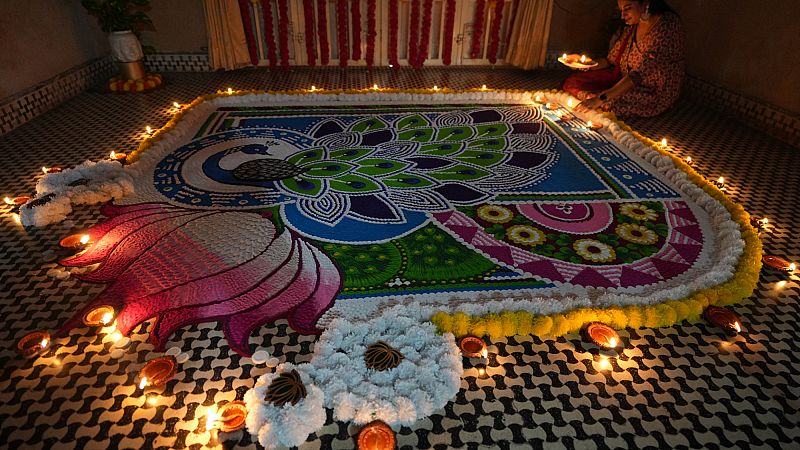Devotees prepare to celebrate Diwali

Nestled in the heart of west London is the BAPS Shri Swaminarayan Mandir, a vast white marble temple that has become a spiritual landmark for the city’s Hindu community.
Built in 1995, this is one of the largest Hindu temples outside India and a centre of worship for tens of thousands of people each year.
With only days to go until Diwali, which this year falls on 20th October, the temple is alive with prayer and preparation.
As dusk falls, worshippers gather for the evening Arati, one of the final daily prayers before the festival begins.
The ceremony combines chanting, rhythmic music and the waving of lit lamps - an act symbolising the removal of darkness and ignorance.
Monks known as swamis lead the congregation through verses of devotion, while the air fills with the scent of incense and the sound of bells.
The service takes place before ornate golden shrines housing sacred figures known as murtis, each dressed in colourful robes and adorned with flowers and jewels.
Volunteer Shaumit Saglani explains the story behind Diwali.
"Diwali dates back to the time when Bhagwan Ram returned home after victory over Ravan, so hence the festival known as good over evil. And on his journey home the paths were lit up with light, candles obviously in those days, and hence it's known as the festival of light. But more than that, it’s understanding that every year, every day we're faced with challenges and that if we turn to God, who is our light, he will guide us."
Across India and the wider world, Diwali celebrates the triumph of light over darkness, knowledge over ignorance and hope over despair.
It's also observed by Sikhs, Jains and some Buddhists, each attaching their own meaning to the festival.
Inside the temple, worshippers walk clockwise around the main shrine. This is a practice called Pradakshina, which symbolises humility and the belief that God is at the centre of life.
Saglani says the celebrations are as much about gratitude as they are about light.
"In this time of the year, which is the most important celebration in the Hindu calendar, it's important to appreciate what God has given to us — family, friends, health and life. So it's all encompassed during the festival of Diwali."
Beyond the prayer hall, a small army of volunteers work late into the night preparing for the crowds expected over the coming days.
Here they're assembling seventy thousand boxes of 'prasadam', food that is first offered to the deities during worship and then shared among devotees as a blessing.
The boxes contain handmade Indian sweets such as ladoo, barfi and chevdo, along with savoury snacks, all made inside the temple from scratch.
Nilima, a volunteer at BAPS Shri Swaminarayan Mandir, says:
"The items we’ve got today here are three sweet dishes and one savoury. We’re packing all these in thousands and they’ll be handed out on Annakut Day and Diwali Day."
The preparations are part of Annakut, meaning “mountain of food”, which marks the start of the Hindu New Year.
Hundreds of dishes are displayed before the deities as an act of devotion and gratitude.
This year, volunteers are creating elaborate vases decorated with coloured lotus seeds and cereal, as well as models representing the bridges of Paris, a nod to a sister temple opening there in 2026.
Divya, a volunteer at BAPS Shri Swaminarayan Mandir says: "Our main aim is to make our Guru happy by offering this type of devotion. We do it all together, which our Guru loves — it’s unity and faith in action."
Hetvi, another volunteer, says: "Diwali is a time of togetherness and joy, and of course light, as that’s the main meaning of Diwali. In the temple we celebrate it with love, which I really appreciate."
As preparations continue in London, similar scenes unfold in temples and homes around the world.
Fireworks, sweets and lamps mark the victory of light and the arrival of a new year.
As worshippers prepare for Diwali and the dawn of a new year, the temple’s halls echo with music, colour and faith.

